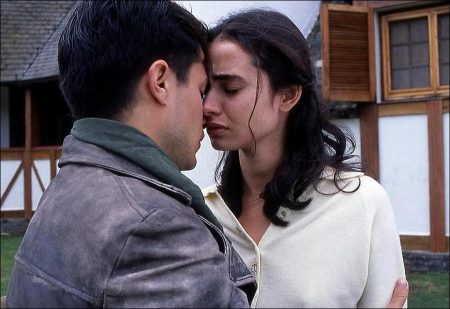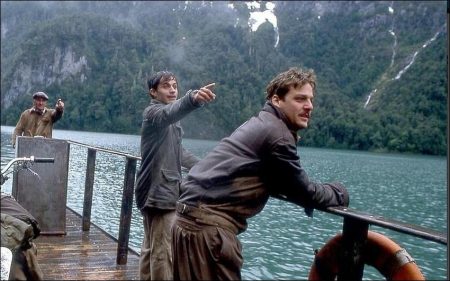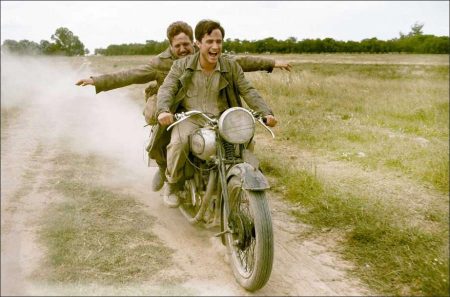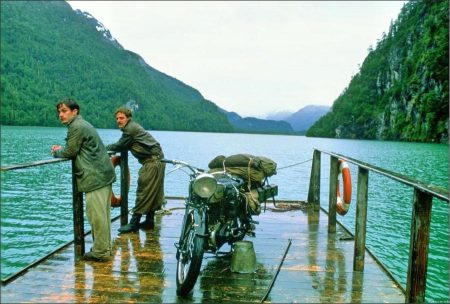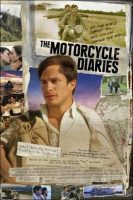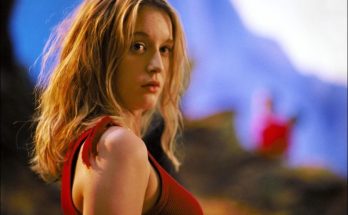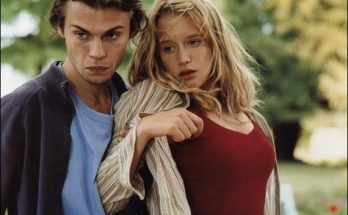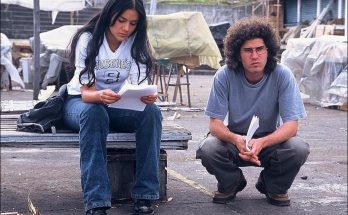About the Production
I’ll leave you now, with myself, the man I used to be… — Ernesto Che Guevara in The Motorcycle Diaries
Ernesto Guevara’s The Motorcycle Diaries is not the travel journal of the man who would become one of Time Magazine’s “icons of the century.” Rewritten by Guevara several years after the journey took place, it is a memoir. The entries from his travel diary depicting the events and people encountered on the trip, combined with his ruminations on their later significance, provide a rare opportunity to witness the retracing of a remarkable man’s destiny and the solidifying of his identity from its earlier state.
The Motorcycle Diaries originated at South Fork Pictures with executive producer Robert Redford, and producers Michael Nozik and Karen Tenkhoff of Wildwood Enterprises. They immediately saw the project as a prime opportunity to work with Walter Salles, the director who had won the Sundance-NHK Cinema 100 grant in 1996 with the script for Central Station.
Redford comments, “The Motorcycle Diaries seemed like the perfect way to collaborate with Walter, especially since Che Guevara can be such a tricky subject. I knew Walter would handle the story with lyricism and humanity rather than focusing on the politics of who Ernesto would later become.”
The director was already quite familiar with the book when the producers approached him to helm the film. He explains, “Guevara’s book had had a real impact on me because it is about a journey to discover not only one’s identity and one’s place in the world, but also about the search for what I think we could call a Latin American identity. I was very moved by the intertwining of this personal search with one that had a larger meaning for all of us who come from those latitudes. When you finish reading this book, you have the impression that you can actually change things in the world, by understanding them and taking part. I wanted the film to convey that same sense of hope and exploration.
“The beauty of the journey lies in the fact that Ernesto and Alberto’s perception of the world changed; they didn’t refuse to see. In turn, they would go on to try to change the world, going by what they had come to understand on this journey.”
To bring the coming-of-age story to the screen, the filmmakers enlisted the aid of someone who had been close to the material since its first publication — Italian journalist and documentarian Gianni Minà, who had served as the European editor of Mi Primer Gran Viaje [a.k.a. The Motorcycle Diaries, the travel diary of Che Guevara through Latin America]. Minà remained with the production throughout, as artistic supervisor.
He joined the filmmakers on the first of their several trips to Havana, Cuba. There, they began their comprehensive research, and also met with Guevara’s family – widow Aleida March and daughter Aleida and sons Camilo and Ernesto. They also interviewed Alberto Granado, Ernesto’s close friend and traveling companion, who is now an octogenarian but remains as vivacious as ever.
To adapt Ernesto and Alberto’s books [the latter is Con el Che por Sudamérica (With Che through Latin America, a.k.a. Traveling with Che Guevara)] into a screenplay, Salles and the producers selected José Rivera. The screenwriter is an award-winning Puerto Rican-born playwright who had studied with Gabriel García Marquez at the Sundance Institute. Salles and Rivera conducted considerable research together, reading all the existing biographies on Guevara. It would take Rivera two years of writing and rewriting, coupled with ongoing research, before the script was finished.
To balance the film’s portrayal of the two main characters, Rivera drew from both Guevara’s travel diary and Granado’s own account of the trip. Unlike The Motorcycle Diaries, Granado’s version is not a memoir. Rather, it contains the actual entries documenting his observations on the road. The immediacy of Granado’s journal was instrumental in not only reconstructing the events that took place within its pages, but also the personality of the charismatic man who wrote it.
Salles says, “José never let the young Guevara be confused with his future mythological image. José was more interested in revealing the human side of these two unique characters. He tried to look at these young men as who they could have been, in that moment in time. He retained the humor that is so vitally present in Guevara’s book, as well as in Granado’s account of the journey. Most importantly, he added layers of gravity as the two travelers went deeper and deeper into their journey – not unlike Ettore Scola did in his screenplay for Il sorpasso [The Easy Life; 1963; directed by Dino Risi and starring Vittorio Gassman and Jean-Louis Trintignant].”
Rivera admits, “There were many challenges in writing this screenplay. How do you even begin to approach an iconic figure like Ernesto Guevara? I wanted to humanize the myth, yet also honor the memory and serve history. It was also important to give Alberto equal weight. “I also sought to capture the inner geography of a boy turning into a man, as well as that flickering pre-1960s Latin America – poised, it seems, between centuries. There was a mind-boggling variety of faces, temperaments, cultures, races and voices.”
Rivera found his inspiration in the writings of the two men whose story he was telling. He acknowledges, “Guevara once wrote that a true revolutionary was guided by great feelings of love. Ultimately, a screenwriter’s greatest and most singular gift to any film is his or her love for the themes and people of the project at hand. In this respect I was lucky; writing the screenplay and balancing its many demands required a lot of hard work, but lending my love to stories of young Ernesto Guevara and Alberto Granado was easy.”
While Rivera continued working on the project, the filmmakers found early support for the project at FilmFour. In 2001, executive producers Paul Webster and Rebecca Yeldham joined The Motorcycle Diaries team and began pitching in on the development, and FilmFour financed the picture. Producer Edgard Tenembaum’s newly formed Tu Vas Voir [French for “you’ll see”] Productions came aboard as well.
In the meantime, Salles set out on a personal journey through the towns and cities mentioned in the books to experience firsthand the route that Guevara and Granado had taken some 50 years prior. The director found he was able to reconstruct the adventure and discover the present-day state of the places described in Guevara’s and Granado’s accounts.
Salles states, “The first impression I had in retracing their steps was that the structural and social problems that caught both Ernesto’s and Alberto’s attention in 1952 are mostly still present today; what was transmitted on the page was still pretty much what I felt in taking the journey.
“What came as a revelation to me was how modern and contemporary both books felt – and that may be because the political and social realities of the Latin American culture have not changed all that much since the 1950s.”
The Motorcycle Diaries should and would be an Argentine film, all concerned firmly believed, so as to honor the origins of the film’s main characters. Once the script was completed, the filmmakers began to prepare for filming. The production office was established in Argentina, with co-producers Daniel Burman and Diego Dubcovsky’s BD Cine pacted as the project’s Argentine partner. Further following the trajectory of the real-life journey, a Chilean partner was enlisted in Sahara Films, and Inca Cine became the project’s Peruvian partner.
Furthering the commitment to authenticity, Salles and the creative team endeavored to shoot the film where the journey actually led. To that end, the first full location scouting took place in early November 2001, when the production team visited Argentina. Full scouting throughout the different countries that the two friends had visited 50 years prior began in January 2002 and continued until May.
Equally important to maintaining the authenticity of the film, and the different cultures portrayed, was the decision to use local actors for and from each region. Casting sessions were held all across Latin America, and actors were selected from Argentina, Chile and Peru.
However, for the role of Ernesto Guevara, Salles made an exception; Mexican actor Gael García Bernal, whom the director describes as “one of the most talented actors of his generation,” was offered the role. Drawn by the opportunity to incarnate a legend in his formative period, Bernal instantly accepted.
Bernal notes, ”[My generation] was born with the idea of a modern Latin American hero. Che has had a strong influence on our lives, especially for those of us born after the Cuban Revolution. He was a man who struggled for his beliefs, an Argentinian man who fought in a country that was not his country. He became a citizen of Latin America, a citizen of the world…I think The Motorcycle Diaries can strengthen people into searching for their own beliefs.”
With their Guevara cast, the filmmakers still needed an actor who would bring the role of Alberto Granado to vibrant life on-screen. During sessions conducted by casting director Walter Rippel in Buenos Aires, one actor stood out – Rodrigo de la Serna. A young performer trained in theater and now busy in all mediums in his native Argentina, de la Serna now makes his international film debut in The Motorcycle Diaries.
Salles states, “Rodrigo’s physical resemblance to Alberto at that age is staggering, but that’s not why I ended up choosing him. Rodrigo performs in the tradition of the great Italian actors like Vittorio Gassman and Alberto Sordi. He is always ready to surprise us, blending humor and drama in a unique manner.
“There was also an incredible coincidence, which I realized only after casting him: Rodrigo de la Serna is a second cousin of Ernesto Guevara de la Serna [on Ernesto’s mother’s side].”
Argentinian actress Mía Maestro, who has been working in the U.S., returned to her homeland to portray Ernesto’s girlfriend, Chichina Ferreyra. The two lead actors threw themselves into preparing for their roles. They read the respective source materials and the biographies. They also viewed new interview footage of Granado that Salles and Minà had shot during one of their trips to Cuba. Bernal also read the books that Guevara himself had read during that period in his life, which included the French existentialists as well as Latin American social theoreticians. De la Serna was given access to Granado’s unedited diaries and also gained 15 pounds to better incarnate the man he was portraying.
In addition, Salles took the two actors to Cuba to meet Granado and the Guevara family. Granado himself would travel to filming locations to lend additional inspiration and support once production was underway.
Bernal and de la Serna also underwent a 14-week period of intensive training and education. During this time, they learned how to ride a 1939 Norton 500 (a second vintage motorcycle, the 1949 Norton ES2, was provided and maintained by key motorcycle mechanic Gustavo Agra) and practiced their soccer skills. De la Serna took mambo and tango lessons, and learned to master the proper accent from Córdoba. For his part, Bernal took classes to perfect his Argentine Spanish, and embarked on daily workouts to achieve the athletic form that Guevara had. That fitness program paid dividends when it came time for Bernal to spend nights shooting the pivotal sequence where Guevara swims across the Amazon.
Crew members joined the two actors at seminars and lectures which the filmmakers organized to further everyone’s knowledge and inform their work. Among the topics explored were Argentinian cinema history; the Incan Empire; pop music of the 1950s; and Argentina, Chile, and Peru during the 1950s.
The filmmakers also relied on Luis Valdez and Ricardo Achenbach as consultants on leprosy, given the condition’s pivotal appearance in the journey. Regarding Guevara’s own condition, Dr. Guillermo Menga provided insight into the effects of asthma during the 1950s.
While the actors continued to immerse themselves in training and preparations, the director continued the process of refining and defining his overall aesthetic for the film. Salles and his team drew inspiration from the photographs taken by Guevara during the trip, as well as from the evocative work of Aimará photographer Martin Chambi.
Production designer Carlos Conti reconstructed the era and established proper historical context, but also incorporated slightly modern, progressive elements that would underscore the timelessness of the story’s themes and the exploratory hopefulness of Guevara’s journey.
Conti explains, “Considering that Che is a modern hero, I thought contemporary touches would be appropriate. We tried to create a very subtle set so period decoration would not overwhelm the actors in their environment. [Director of photography] Eric Gautier, [costume designers] Beatriz Di Benedetto and Marisa Urruti, and Walter Salles and I agreed that we would use a limited palette of colors. We wanted to create a unified look for the film, despite the many locations.”
Collaborating with cinematographer Gautier, Salles developed a specific cinematic style for The Motorcycle Diaries. Salles had early on made the creative decision to shoot the film in sequence, and worked with Gautier to create a natural rhythm for the shot selections.
Salles reports, “We opted for a simple, direct cinematic grammar to tell this story. We liked the simplicity of the super 16mm format, and we blended it with a few images shot at night on 35mm. Most of the time, I refrained from mapping out a mise-en-scène. I tried to be carried by the flow of what we were finding on the road, and not impose preconceived ideas. We were also trying to do the opposite of what one might call ‘induced documentary.’ We basically tried to film the story as if it were unfolding before our very eyes.”
Salles took a comparable approach in developing the script with Rivera. The director notes, “I felt that the film should be constructed out of layers. A road movie has by definition an episodic quality, and that can be a pitfall if you don’t allow time for the information to sink in slowly and unforced. In this story, the social and political reality of Latin America take hold little by little, like layers of gravity. What I wanted to convey, through the extraordinary Gael and Rodrigo, is that there is not a defining moment where everything changes.
“Rather, the layers are delicately superimposed in such a way that you understand that these young men have been transformed by the journey. For this narrative, we needed the silence in order to hear the chaos, and we needed to respect the internal timing and growth of the characters. We didn’t want to impose an unnatural rhythm on the story; we wanted to let it evolve quietly until it ends.”
Principal photography began in mid-September 2002 and lasted 84 days. The film was shot in over 30 locations where most of the actual events occurred – Buenos Aires and Bariloche, in Argentina; Temuco, Atacama Desert, and Valparaíso, as well as the mine visited, in Chile; and Iquitos and Machu Picchu, in Peru.
The decision to shoot in chronological order provided the opportunity for parallels to take shape between the production and the journey it was retracing. Shooting on actual locations – at times as exotic to the actors as they had been to Guevara and Granado – kept the spirit of exploration alive and encouraged everyone’s creativity.
Salles reflects, “Little by little, we integrated what was generously being offered to us by reality into the filmic structure. Most specifically, that happened from the point where the bike expires – which reflects, interestingly enough, what both Alberto and Ernesto tell in their respective diaries. While they were on the bike they had the possibility of going from point A to point B, but once the bike broke down, they were obliged to hitchhike and walk.
That put them in a position to make much more direct contact with the people of Latin America. “The same thing happened to us as we were entering deeper and deeper into the heart of Latin America, and most especially when we arrived in Peru and encountered the Incan heritage. We were approached by Indians who spoke Quechua and asked us to initiate a dialogue, and we integrated the results of those encounters in the film. These scenes are close to the spirit of the original journey.”
In January 2004, 52 years after that original journey began, The Motorcycle Diaries world-premiered at the 2004 Sundance Film Festival. It was greeted with a standing ovation.
In the end, the journey that the filmmakers themselves undertook in order to bring the inspiring story to the screen helped – and continues to help – them explore new territory.
Salles says, “If there’s one thing I can tell you about this experience that we shared – ‘we’ being the group of people who went on the road together for two years to do this project – it’s that, like Ernesto and Alberto, we were very different when we got to the end of our journey in comparison to where we were when we started it.”
The Motorcycle Diaries (2004)
Directed by: Walter Salles
Starring: Gael García Bernal, Jaime Azócar, Rodrigo De la Serna, Ulises Dumont, Facundo Espinosa, Susana Lanteri, Mía Maestro, Jean Pierre Noher, Mercedes Morán
Screenplay by: Jose Rivera
Production Design by: Carlos Conti
Cinematography by: Eric Gautier
Film Editing by: Daniel Rezende
Costume Design by: Beatriz De Benedetto, Marisa Urruti
Set Decoration by: Carlos Conti
Art Direction by: Graciela Oderigo, Laurent Ott, María Eugenia Sueiro
Music by: Gustavo Santaolalla
MPAA Rating: R for language.
Distributed by: Focus Features
Release Date: September 24, 2004
Views: 223
